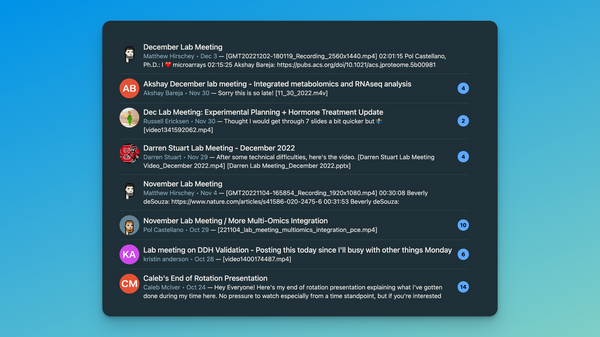100% of research labs have LAB MEETINGS. 0% are set up to enable everyone to have a voice. This is how we flipped them to increase engagement hear, from everyone, and save time...
Most lab meetings are run on some variation of: -scientist presents either data or journal article -starts with a background -gives some results -future directions The end of the presentation is for questions. Right? Wrong.
The pandemic brought into focus two types of communication: -one-way (I tell you something) -two-way (I tell you, and you tell me something back)
The problem with lab meeting structure: most of the time spent together is one-way communication Presenters gonna present.
Because of the time constraints the pandemic introduced (esp for parents of young kids, caregivers, etc), all were forced to ask: how can we best spend our limited time together?
Championed by @plibin and @mmhmmapp, the pandemic encouraged us to 'offload' one-way communication to an asynchronous format. And save two-/multi-way communication for synchronous time together (either in-person or virtual)
How does this distinction work for lab meetings? Communication for presenting data (one-way) should be asynchronous. Communication for discussion (two-way) should be synchronous.
Our *monthly* lab meetings run like this: Lab meetings are on Fridays. Leading up to Friday... Monday (by the end of the day): record your lab meeting presentation and post it to our lab communication platform (we use @basecamp)
Tuesday-Thursday: everybody watches the posted presentations and writes comments, questions, and ideas. The presenters can either post answers back (most common) or save them until Friday.
On Friday, we have ~2hour synchronous lab meeting (so far, still all virtual) where the presenters will - give a **short** summary of their presentation (think 1-2 slides) - answer questions/comments/posts - focus on future directions
This flipped lab meeting format has soooooo many benefits: Benefit 1. People watch lab meeting videos when it is convenient for them. Night owls, parents, and pet lovers rejoice.
Benefit 2. PAUSING PRESENTATIONS! Whether you spaced out, needed to look up something, or missed a key point, pause, go back, and play it again.
Benefit 3. Asynchronous threaded messaging enables anyone to ask questions or share their ideas (eg, see @slackhq). Platforms that encourage voices from cultures where public question-asking is not the norm, trainees, introverts, and beyond ensure diverse ideas are shared.
Benefit 4. The best ideas can simmer. Scientific creativity and problem-solving require exploration & evaluation. Both of which take time. Disentangling the presentation from the discussion permits the best ideas to present themselves.
Benefit 5. Efficiency. You've heard the joke about the meeting-that-could-have-been-an-email... What about the presentation-that-could-have-been-a-video? Lab meetings waste too much time on "background" sections. Live presentations jump straight to the discussion.
Benefit 6. Archival video Unsure what someone said in lab meeting? Watch the video. New person joining the lab? Watch the video(s). Meeting with a collaborator? Send the video. Old [async] presentation videos or [sync] lab meeting videos have a shelf-life far beyond their date.
Benefits 7, 8, 9...I could keep going. But I'm gushing. So I'll stop.
Do science better. Flip your lab meetings. Enable everyone to have a voice.
What do you think of flipped lab meetings? Could it work for your lab?
I recently shared these ideas on twitter, which whent "academic viral", amassing over 1M impressions. As I continue to experiment, I'm sharing it with you all here.
